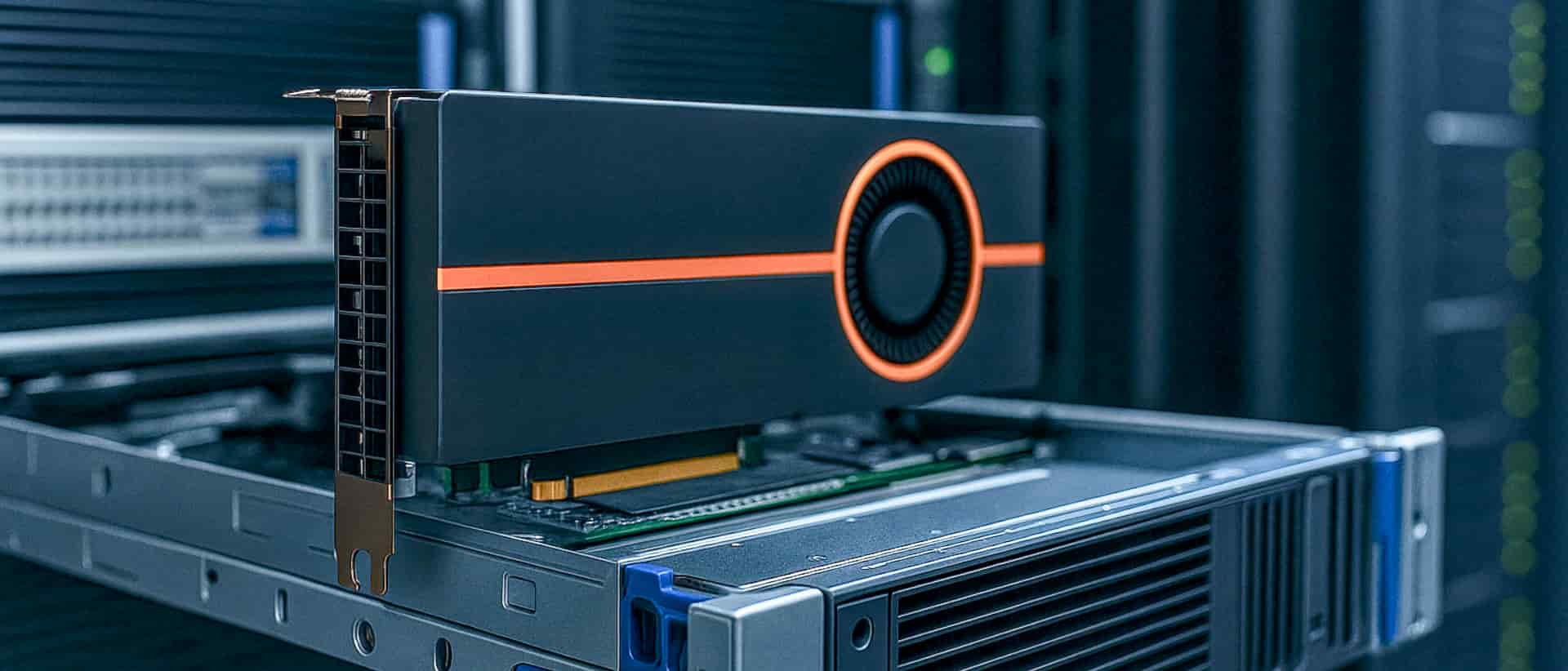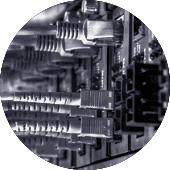What exactly is a GPU dedicated server?
A GPU dedicated server is a server appliance that has one or more Graphics Processing Units (GPUs) installed. The original purpose of the GPUs is to accelerate the rendering of 3D graphics and video in computer systems. They handle the complex mathematical calculations required to create visuals. This makes them an essential component in every computing system that provides gaming services, completes creative tasks like video editing, virtual reality (VR), and augmented reality (AR).
Other very important use cases of the GPU based servers are various scientific simulations, engineering computations, machine learning models, AI inference tasks, accelerating big data queries, real-time data visualization, hashing calculations needed to secure blockchains, MRI/CT scan image reconstruction, genomics and bioinformatics, risk modeling, algorithmic trading, real-time sensor data processing, etc.
They are are widely used in data centers and edge servers for AI workloads.
Can I install multiple GPUs in one dedicated server?
Yes, a server chassis can hold between two and ten graphics processing units (GPUs). A 2U form factor server chassis can handle one to four GPUs. A 4U server chassis can support up to 10 GPUs.
What distinguishes Cloud from Bare Metal GPU Servers?
Bare Metal GPU Servers (GPU-powered dedicated server appliances) provide their users with full control over the physical infrastructure and guarantee the computing performance. The Bare Metal GPU Servers are not delivered under complex computing infrastructure delivery models, used by the large hyperscale clouds. So there are no hidden per-hour costs or usage limits. Users of GPU dedicated servers available on HostColor.com pay a flat monthly service fee, and have full control over both over the technology and billing processes.
Which GPUs are available on HC dedicated servers?
We offer instantly delivered dedicated servers (up to 1 hour server delivery) with Nvidia T1000 8GB, Nvidia Tesla P4 8GB, Nvidia RTX 3070, 3080, 3090 and GeForce RTX 5080 and 5090 series GPUs, GeForce RTX 4090D, Nvidia Quadro RTX A4000, A5000 and A6000 GPU series, Nvidia Quadro 5000, 6000 and 8000, Quadro RTX 4000, and Nvidia A40, A100 series GPUs.
What CPUs and RAM are used with the GPUs?
HostColor's GPU-enabled dedicated servers are equipped with high-performance CPUs and scalable system memory. The most used CPUs on GPU-powered dedicated servers are AMD EPYC 7502, 7452, 7662, 7702, and 7742 processors, AMD EPYC 7443P, AMD EPYC 7543 and 7543P AMD EPYC 9254, AMD EPYC 9274F, AMD EPYC 9275F, AMD EPYC 9355P, 9374F, 9474F, 9575F, 9654 & 9354P, and 9754 CPUs.
The memory (RAM) options, start at 128 GB and are expandable up to 2 TB RAM, depending on the server model.
Our servers offer optimized CPU-to-GPU ratios, ensuring that workloads such as AI training, rendering, big data run smoothly without resource contention.
Do HC GPU servers support virtualization and GPU passthrough?
Yes. GPU servers can be virtualized with VMware, Proxmox, or KVM, enabling GPU passthrough to multiple virtual machines. This allows resource sharing across teams or projects.
What is the Hailo-8 AI processor?
Hailo-8 AI is a high-performance artificial intelligence accelerator designed for use in edge server appliances. The Hailo-8 AI Accelerator integrates with processors like Raspberry Pi, Intel, and AMD to handle artificial intelligence tasks like object detection and video analytics for applications in autonomous vehicles, smart cities, and various industrial automation workflows. Servers that use Hailo-8 AI offer real-time neural network inference at high speeds and are used for hosting industrial-grade camera devices and robotic systems.
What is Google Coral (Google Coral)?
Coral (also known as Google Coral) is a hardware toolkit designed to support the development and deployment of machine learning applications at the "edge." Coral operates locally on edge-dedicated server appliances, eliminating the need for major cloud service application networks. At the core of the toolkit is the Google Edge TPU, a custom-built ASIC designed for high-speed, low-power machine learning (ML) inference using TensorFlow Lite models. Coral offers a variety range of server products, USB accelerators and single-board server appliances. When used on servers, Coral's products enable developers to bring powerful local AI capabilities to embedded systems and various applications.
Can I have a dedicated GPU cloud infrastructure?
You can use your preferred cloud computing virtualization technology to create and deploy a dedicated GPU cloud infrastructure on a single physical server or cluster of servers. If you want to create a cluster of two GPU-powered dedicated servers, they can be directly interconnected using 1GE or 10GE NIC cards. If you need HostColor's help to create a GPU-powered cloud computing architecture, we can help you design, deploy and manage it as needed.
Can I Have Business Continuity GPU-Powered Infrastructure?
Yes, any organization can use two or more physical GPU-powered bare metal servers to deploy a customized Business Continuity scenario. The term "Business Continuity" describes an active, fully operational IT infrastructure model that enables an organization to maintain its technology operations and workflow with virtually no interruption in the event of a failure or outage of its primary technology infrastructure.
Does HC provide GPU dedicated servers with AMD CPUs?
Yes, we provide GPU Dedicated Servers with a wide choice of hardware configurations with various AMD Ryzen and AMD EPYC processors. You can select the service location and fully customize the GPU Server, starting with the edge location, CPU, RAM, memory type and capacity, bandwidth, port, and data transfer quota.
How much does a GPU dedicated server cost?
The entry-level, Semi Managed GPU dedicated server with a Nvidia T1000 8GB, an included operating system and customer support starts at around $160 per month. For example, at that price, customers can rent a server with an Intel Xeon Processor, 4 to 8 CPU Cores, 16 GB - 64 GB of RAM, and one or two storage drives. To ensure fast data processing, it is recommended that the storage drive be an SSD or NVMe drive.
HostColor recommends using GPU servers with two or more storage drives that can be configured with a Redundant Array of Independent Disks (RAID) types 0 or 1.
Another important feature is finding a GPU dedicated server hosting service with unmetered bandwidth and unlimited data transfer. Why is this so important? Because if the server is provisioned with metered data transfer, measured in terabytes (TB) per month, and the installed applications reach the data transfer quota, the internet connection will be suspended or severely restricted, or the server user will incur overage fees. To avoid these charges, server owners should avoid hyperscale cloud providers with perplexing bandwidth and data transfer usage and billing models that charge customers for each gigabyte of incoming or outgoing internet traffic.
HostColor's solution to prevent overcharging server owners is simple: to provide GPU dedicated servers with internet connection ports ranging from 1 Gbps to 100 Gbps and unmetered bandwidth rates beginning at 250 Mbps. With these servers, users are not be charged for overage data transfer.
Are there GPU Dedicated Servers with Unlimited Bandwidth?
Yes, but since nothing tangible is unlimited, we need to specify what we mean by "unlimited bandwidth". If by "GPU dedicated server with unlimited bandwidth", we mean a GPU server with no preset limit quota for the transmitted incoming and outgoing Internet traffic and without charges for overage data transfers, then HostColor offers bare metal GPU servers with unlimited bandwidth up to the size of the physical network connection.
There are two models of delivering network services and internet traffic on the cloud and dedicated servers - one measured by the allocated "Bandwidth" quota (in Mbps or Gbps), the other measured by the transmitted "Data Transfer" (in megabytes or terabytes).
"Bandwidth" describes the overall data volume (in Mbps or Gbps) that can be transferred usually in a period of 30 days. "Bandwidth" is also a term used to describe the size of the internet connection port - for example, 1 Gbps, 10 Gbps, 20 Gbps, etc.
"Data Transfer" is the monthly amount of data in terabytes (TB), allowed to be transferred over your internet port.
What security is included in my GPU dedicated server ?
Providers of GPU Server infrastructure offer the following levels of security with their dedicated hosting services:
1. Physical Environment Security
Physical environment security refers to all physical aspects of the data center facility used to host GPU servers. This includes the resilience against natural disasters, the physical design of the data center and the way the server rooms and cabinets are organized, as well as power redundancy, Internet network redundancy, and overall business continuity.
2. Network Security
Network security is part of the overall data center communications architecture. It includes the redundancy of fiber connectivity routes and the wide choice of ISPs and interconnection options.
3. Physical Server Security
This can also be referred to as "Bare Metal Server Security". It refers to the specific hardware components and configurations of the GPU server that increase its operational availability. These include the number of power supplies (PSUs) used, the number and capacity of network interface cards (NICs), the number and specification of hard drives used (SATA, SAS, SSD, NVMe, etc.), the use of RAID controllers, the Intelligent Platform Management Interface (IPMI), also called ILO and iDrac by server vendors) for remote network access to the server, etc.
As a provider of GPU dedicated servers, HC automatically covers the highest possible industry standards regarding "Physical Environment Security" and "Network Security". The "Physical Server Security" is a customizable element of the dedicated hosting server, which is a choice of the user of the physical server (i.e. the customer).
Most of our GPU dedicated servers include the following "Physical Server Security" by default:
- Redundant Power Supplies (PSUs)
- At least 2 x 1 Gbps physical Network Interface Cards (NICs)
- Intelligent Platform Management Interface (IPMI) and IPMI capabilities, except for the Edge servers, which are shipped with SSH management access only and are not recoverable in the event of an operating system (OS) failure that renders the server inoperable
Is my GPU Server protected against DDoS attacks?
Yes. HostColor's DDoS-protected GPU dedicated servers and cloud infrastructure minimize the risk of service unavailability and virtually eliminate the risk of you incurring data transfer costs as a result of artificial, bot-generated traffic to your server instances.
When you use our GPU servers, your applications run behind sophisticated DDoS protection firewalls, maximizing application availability. Our enterprise-grade, DDoS-protected networks safeguard your IT infrastructure from unexpected network downtime, preventing loss of business and revenue. Our DDoS-protected network services filter out malicious traffic and ensure that legitimate traffic requests reach your servers and applications. Specifically, our DDoS protection includes the following capabilities:
- Real-time mitigation of malicious attacks
- Human-generated traffic that reaches your dedicated servers or cloud instances
- Native protection against network attacks of any size
- No additional fees or charges for DoS and DDoS protected servers and infrastructure
- No fees for bot-generated and malicious traffic on all unmetered bare-metal dedicated servers and dedicated clouds
- No increased latency and long round-trip delays in application delivery in the event of a network attack
- All IPv4 and IPv6 settings are protected from DDoS attacks









